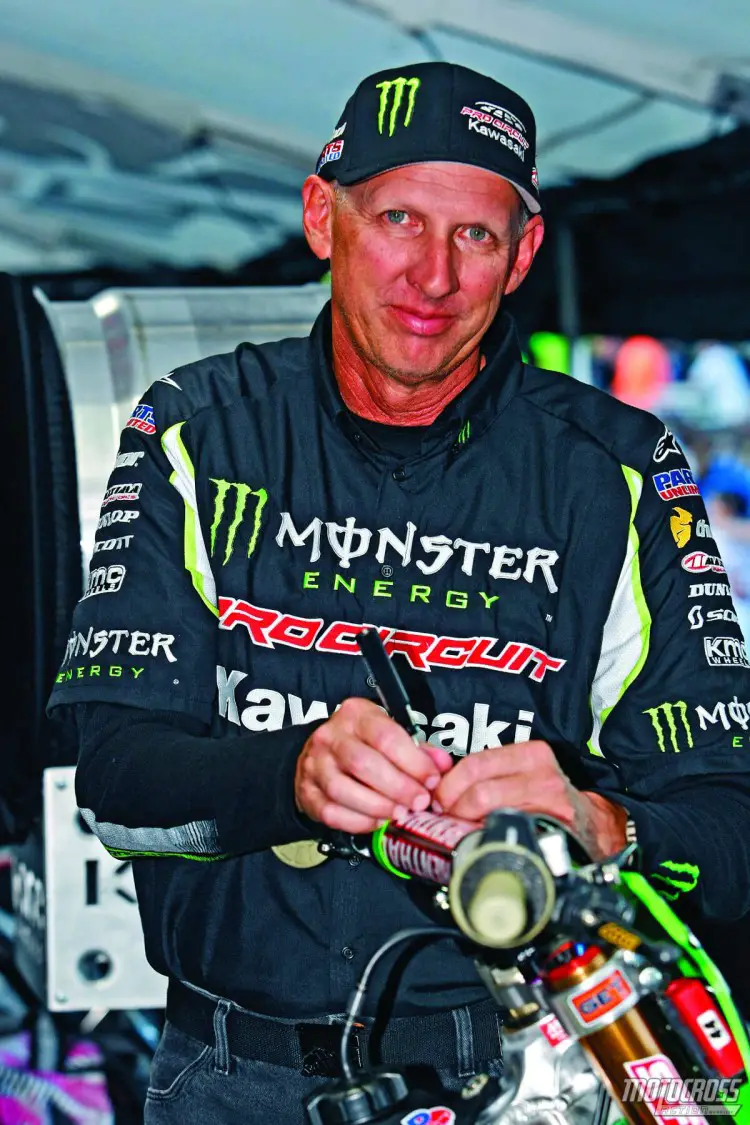BARE BONES: DANGERS OF ROUTINE MAINTENANCE
By Bones Bacon
Imagine you are at Loretta’s on the first practice day and a dad rolls his bike under your tent and says his son is having handling problems. He asks, “Can you fix it? Everything was great at home. In fact, just before we loaded up for the trip, I went completely through the bike and fixed everything that was worn out and adjusted everything that needed adjusting. Now my son says the bike feels harsh, is out of balance and won’t turn. What do you think is wrong?”
I hear this all the time. Routine maintenance is a good thing, but you can’t take a bike that a rider is comfortable with and completely rebuild it, freshen everything up, adjust all the gizmos, and throw on a new chain and sprocket the day before a big race. That is like buying new running shoes on the morning of the Boston Marathon. Your race bike should feel like comfortable shoes. At the Pro Circuit Kawasaki team, we go to great lengths to make sure that every team rider’s practice bike is the same as his race bike for this very reason.
That doesn’t mean that you shouldn’t keep up on your maintenance with new tires, fresh clutch plates and clean oil, but be very careful of any major overhauls unless you have enough time for the rider to adjust to the new feel. Lots of riders decide that since they are going to a big race they need to run race gas, even though they don’t run race gas at home. Don’t do it. Dance with the one who brought you to the party!
The big race is not the proper place to try out a new widget. That’s what practice tracks are for. Even the most inconsequential things can drastically affect how a bike handles. Adding a tooth to get a little more drive will alter the amount of leverage the swingarm exerts on the shock, which in turn will change the sag, the wheelbase and the basic handling characteristics of the bike. One tooth on a sprocket changes the axle position about 4mm, and one chain link longer or shorter will change the axle position about 15mm—that is a huge geometry change.
“NEW PARTS WITH TIGHTER TOLERANCES CAN CHANGE THE CHASSIS HEIGHT, WHICH CONTROLS THE BALANCE OF THE BIKE. YOUR OLD PARTS
ARE WHAT IT KNOWS BEST”
New parts with tighter tolerances can change the chassis height, which controls the balance of the bike. Your old parts are what it knows best. New ones may alter the way the rear of the bike moves. If you must put new parts on your rear suspension or change the gearing, you need to check some basic measurements. When your bike is new and set up perfectly, measure the back of the bike on the stand, just as though you were setting the sag, except measure to the farthest part of the swingarm and not to the axle. We have our mechanics take this measurement every time a race bike comes off the track. We often find that the measurement has changed significantly, normally because of a bent bolt, linkage or subframe.
Additionally, when we rebuild a bike, we take if off the stand and put weight on it to take all the slop out of the bolts as we tighten everything up (e.g., engine, subframe, linkage, axle, pivots, etc). That way we get to where the bike will eventually settle much quicker. The chassis height will be spot-on the moment the rider throws a leg over his bike.
Another problem I notice is evidenced by the front axle sticking out past the axle lug. This is a sure sign that the forks are misaligned and binding. Most bikes have axles with 19mm Allen hexes in one end. Always use a 19mm Allen or wrench to screw the axle into place. This way the axle is spinning inside the lugs, and it will find its happy spot and self-align, keeping everything working smoothly. Do not hit it with a hammer.
Another thing that changes how a bike feels is how tight the bolts are. Our team mechanics use a torque wrench on every bolt. One bolt that isn’t torqued to the right spec could make a big difference in the bike’s handling. This applies especially to the front-axle pinch bolts, triple-clamp pinch bolts and swingarm pivot bolts.
I confess that one new part (or loose bolt or minor axle change) may not be that big of a deal by itself, but when you add them up, they have the potential to make a world of difference. Bottom line: try to be consistent in everything you do with the bike, whether it is for practice or racing, so the rider is comfortable and the bike fits him like a nice, comfortable pair of boots—but not a comfortable, worn-out sloppy pair of boots.





Comments are closed.